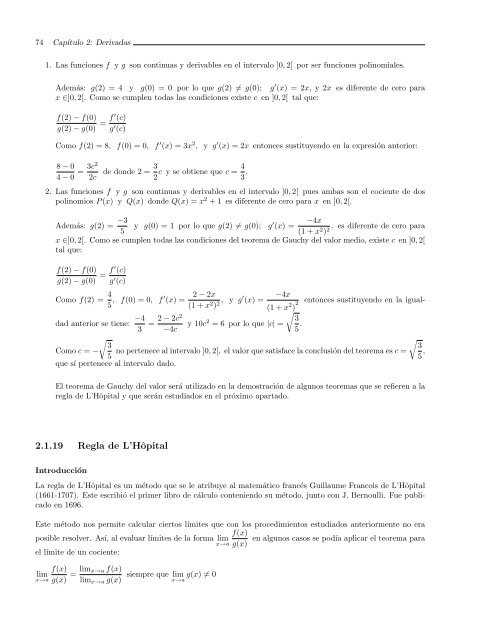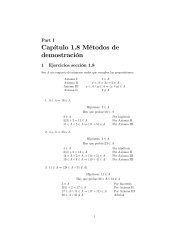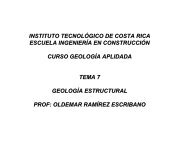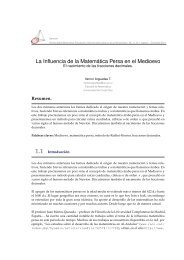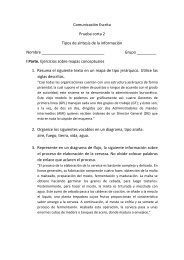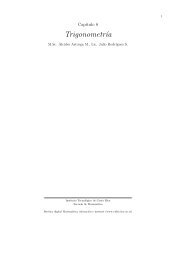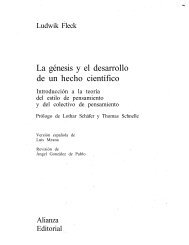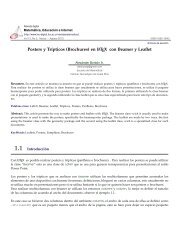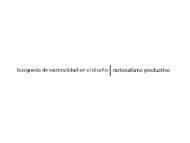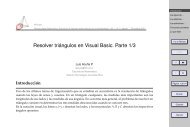Derivada de una función - TEC-Digital
Derivada de una función - TEC-Digital
Derivada de una función - TEC-Digital
Create successful ePaper yourself
Turn your PDF publications into a flip-book with our unique Google optimized e-Paper software.
74 Capítulo 2: <strong>Derivada</strong>s<br />
1. Las funciones f y g son continuas y <strong>de</strong>rivables en el intervalo ]0, 2[ por ser funciones polinomiales.<br />
A<strong>de</strong>más: g(2) = 4 y g(0) = 0 por lo que g(2) = g(0); g ′ (x) = 2x, y 2x es diferente <strong>de</strong> cero para<br />
x ∈]0, 2[. Como se cumplen todas las condiciones existe c en ]0, 2[ tal que:<br />
f(2) − f(0)<br />
g(2) − g(0) = f ′ (c)<br />
g ′ (c)<br />
Como f(2) = 8, f(0) = 0, f ′ (x) = 3x 2 , y g ′ (x) = 2x entonces sustituyendo en la expresión anterior:<br />
8 − 0 3c2<br />
=<br />
4 − 0 2c<br />
3<br />
4<br />
<strong>de</strong> don<strong>de</strong> 2 = c y se obtiene que c =<br />
2 3 .<br />
2. Las funciones f y g son continuas y <strong>de</strong>rivables en el intervalo ]0, 2[ pues ambas son el cociente <strong>de</strong> dos<br />
polinomios P (x) y Q(x) don<strong>de</strong> Q(x) = x 2 + 1 es diferente <strong>de</strong> cero para x en ]0, 2[.<br />
A<strong>de</strong>más: g(2) = −3<br />
y g(0) = 1 por lo que g(2) = g(0); g<br />
5<br />
′ (x) = −4x<br />
(1 + x2 , es diferente <strong>de</strong> cero para<br />
) 2<br />
x ∈]0, 2[. Como se cumplen todas las condiciones <strong>de</strong>l teorema <strong>de</strong> Gauchy <strong>de</strong>l valor medio, existe c en ]0, 2[<br />
tal que:<br />
f(2) − f(0)<br />
g(2) − g(0) = f ′ (c)<br />
g ′ (c)<br />
Como f(2) = 4<br />
5 , f(0) = 0, f ′ (x) =<br />
2 − 2x<br />
(1 + x 2 ) 2 , y g′ (x) = −4x<br />
(1 + x 2 2 entonces sustituyendo en la igual-<br />
)<br />
dad anterior se tiene: −4 2 − 2c2<br />
= y 10c<br />
3 −4c<br />
2 <br />
3<br />
= 6 por lo que |c| =<br />
5 .<br />
<br />
3<br />
3<br />
Como c = − no pertenece al intervalo ]0, 2[, el valor que satisface la conclusión <strong>de</strong>l teorema es c =<br />
5 5 ,<br />
que sí pertenece al intervalo dado.<br />
El teorema <strong>de</strong> Gauchy <strong>de</strong>l valor será utilizado en la <strong>de</strong>mostración <strong>de</strong> algunos teoremas que se refieren a la<br />
regla <strong>de</strong> L’Hôpital y que serán estudiados en el próximo apartado.<br />
2.1.19 Regla <strong>de</strong> L’Hôpital<br />
Introducción<br />
La regla <strong>de</strong> L’Hôpital es un método que se le atribuye al matemático francés Guillaume Francois <strong>de</strong> L’Hôpital<br />
(1661-1707). Este escribió el primer libro <strong>de</strong> cálculo conteniendo su método, junto con J. Bernoulli. Fue publicado<br />
en 1696.<br />
Este método nos permite calcular ciertos límites que con los procedimientos estudiados anteriormente no era<br />
f(x)<br />
posible resolver. Así, al evaluar límites <strong>de</strong> la forma lim en algunos casos se podía aplicar el teorema para<br />
x→a g(x)<br />
el límite <strong>de</strong> un cociente:<br />
f(x)<br />
lim<br />
x→a g(x) = limx→a f(x)<br />
limx→a g(x)<br />
siempre que lim g(x) = 0<br />
x→a


